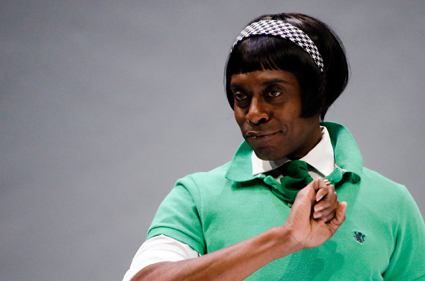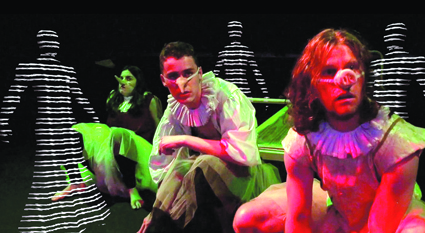staging the really virtual
stephen carleton: a hoax, la boite; making the green one red, qut

Charles Allen, A Hoax
photo Al Caeiro
Charles Allen, A Hoax
I’D BEEN TEACHING STEPHEN SEWELL’S PLAY MYTH, PROPAGANDA AND DISASTER…EARLIER IN THE DAY TO A BRIGHT BUNCH OF DRAMA STUDENTS AND THE LIVELY DISCUSSIONS WE’D HAD ABOUT TOPIC, THEME AND APPROACH WERE STILL WHIRRING AROUND MY BRAIN AS I SAT IN THE AUDIENCE FOR RICK VIEDE’S A HOAX THAT NIGHT.
The students loved the fearlessness and muscularity of Sewell’s writing; his hyperbolic depiction of post 9-11 American paranoia delighted them. They admired the way he hit on the nation’s raw nerve at a sensitive time, and set upon it with a dental drill and ultrasonic scaler. No anaesthetic involved. The American exchange student didn’t appreciate Sewell’s handiwork. She found it arbitrary and borderline negligent.
a hoax
There’s a recklessness to Rick Viede’s writing—one punter described it as unapologetic—that I suspect will elicit similar responses from audiences; there are raw nerves tapped upon here that individuals with unique subject positions in relation to the material will not find easy to stomach. They may need to be warned in advance.
A Hoax is a farce that lampoons some of the most egregious recent literary scandals of authorship identity. Ant Dooley (Glenn Hazeldine) has written a ‘memoir’ about surviving childhood sexual abuse. His survivor though, the ‘I’ in his memoir, is an Aboriginal girl named Currah. Ant conscripts Miri Smith (Shari Sebbens) to assume Currah’s identity. Miri is initially tempted by the money and then seduced by the attention. She disturbs a hornet’s nest when she meets would-be publishing and publicity team Ronnie Lowe (Sally McKenzie) and Tyrelle Parks (Charles Allen). She hasn’t actually read the memoir all the way to the end. When they press her for salacious details about what heinous events took place ‘in the cellar,’ Miri/Currah bluffs and feints. She’s clueless. She eludes—and alludes—as counter-defence. She shrugs in a ‘no-biggy’ kind of way and simply states: “I enjoyed it.” The publicists are appalled—and rapt. The farce ensues from there.
In a post-South Park, post-Family Guy (post-feminist, post-ideological) world, anarchy trumps taste every time. This is a play that would struggle to find an educated audience in the 1990s. It may still struggle in Melbourne. And yet, it’s not gratuitous. The writing has confidence and nuance; the characters are two-dimensional stock farce functionaries, but delightfully so. This is a study of greed, narcissism and disposable culture. An intriguing scene in the second half when a broken and disillusioned Tyrelle violently forces personal accountability from the others dog-legs the piece out of played-for-laughs comedy and probes a little deeper. There may not be redemption here, but there is at least some momentary self-scrutiny.
Lee Lewis’s direction controls the tone and dances adroitly around the ethical dilemma at the heart of the drama: Jason Glenwright’s sharp lighting and Renee Mulder’s pristine white hotel room set sterilise the dis-ease affecting these self-seeking characters; Steve Toulmin’s attractive AV projections of plusher and plusher hotel decors chart the characters’ descent into avarice. This is a tight and feisty production that may ultimately be more entertaining than incendiary and perhaps less scandalous than the scandals that inspired it. It’s terrific theatre.
making the green one red: virtual macbeth

Making the Green One Red
photo Keith Novak
Making the Green One Red
Across the stark QUT Creative Precinct courtyard (where the ghosts of military drills and assembly are never far away) is The Block gallery space. The precinct wears the haunting of its barracks origins lightly. This is somewhat apt for a housing of Kerreen Ely-Harper and Andrew Burrell’s exhibition/installation of a Virtual Macbeth piece, Making the Green One Red. It is also fitting that the piece is located adjacent to two theatre spaces (La Boite’s Roundhouse and QUT’s experimental Loft space). It references—obviously—Shakepeare’s original text; indeed, it spins co-existently off Macbeth’s axis. The question I had in my mind as I entered and explored mixed reality’s digital media homage to the parent text was whether the piece stood on its own feet, or needed the viewer’s familiarity with the play in order to generate meaning. There isn’t a simple answer to this question.
Ely-Harper and Burrell explain the title and the decision to use the witches’ ethereal inner world—their psyche, you could say—to scaffold the piece. The title comes from the point in the text where Macbeth has just killed Duncan and the witches’ prophecy is manifesting as reality: “The vast green waters of the ocean are turned to blood in a process that should be one of cleansing and washing away” (program notes). Instead the green water turns red with blood. For Ely-Harper and Burrell, this is an image not only of transformation, but of transubstantiation. Matter changes form as a result of action and belief. Guilt infects Macbeth and he enters a kind of psychotic state that the witches have manipulated.
Entering Virtual Macbeth is akin to entering this psychic state/world. It is also a little like entering the Haunted House or the House of Mirrors at an amusement park. There is a jouissance of anticipation involved in taking this step into the darkness; anything might happen as the soundscape immerses you (echoed strains of…is it Natalie Cole’s “Unforgettable”?; disjointed phrases of witch-speak; an occasional frightening explosion) and the underworld tour begins. The viewer walks through a series of chambers, each housing a digital media display that evokes Macbeth’s fate. The first is a data projection of the witches’ cauldron on the floor. We see symbols (a crown, a chalice) that conjure Macbeth. The next is the Hall of Psychological Enlightenment—my favourite. A video-recorded projection of a psychologist provides Freudian and Jungian therapy for Macbeth and Lady Macbeth. In other rooms there are recitations of text emanating from a golden light on an empty plinth (The Room of Golden Opinions) or eerie evocations of nightmare as a storm builds and an owl hoots in a lurid red room (the Chamber of Blood). Several of the installations are sound or movement-activated. Some installations are more effective and comprehensible than others (the videoed sequences of actors’ performances didn’t do much for me in this context), but the cumulative effect is tantalising.
The Australia Council provided substantial support for this enigmatic project as part of its digital strategy; it is a well-considered and complex digital media exhibition, ultimately as ephemeral as a theatrical performance. It packs up and moves on to another venue in another city. Does it stand alone? Perhaps not. It would make for compelling foyer art, though; and I would love to enter a live performance of the parent text through an enigmatic portal like this.
A Hoax by Rick Viede. La Boite and Griffin Theatre Company co-production. Brisbane, May 5-26, Sydney July 20-Sept 1; Making the Green One Red, Virtual Macbeth, Kerreen Ely-Harper and Andrew Burrell, mixed reality, The Block Gallery, QUT, Brisbane, April 24 – May 5
RealTime issue #109 June-July 2012 pg. 30






